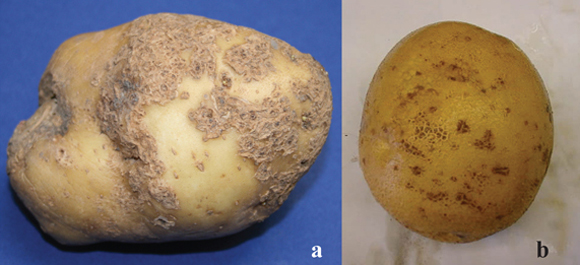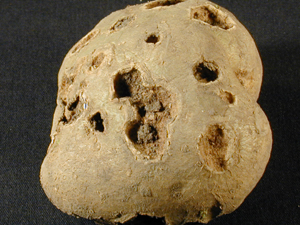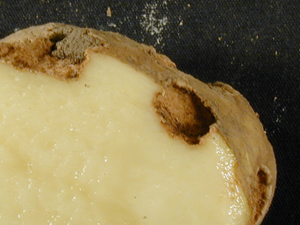G1940
Common Scab of Potatoes
Protect potatoes from surface scab and pitted scab by using resistant varieties and cultural practices that make conditions unfavorable for scab development.
Amy D. Ziems, Extension Educator — Plant Pathology
Alexander D. Pavlista, Extension Potato Specialist
Common scab of potatoes is caused by a soil- and seed-borne bacterium, Streptomyces scabies, which is distributed worldwide. Infection causes tubers to have a scab-like surface lesion (“surface scab”) which results in lower tuber quality. In severe infections, lesions are dark pits that can be as deep as a quarter inch (“pitted scab”). Streptomyces scabies can also attack other root crops, as well as the fleshy roots of weeds. It has been reported on beet, turnip, rutabaga, radish, carrot, salsify, and parsnip.
Symptoms
The symptoms of common scab are quite variable and develop on the surface of the potato tuber. Typically, roughly circular, raised, tan to brown, corky lesions of varying size develop randomly across the tuber (Figure 1). The lesions may be raised or warty in appearance, level with the surface, or sunken into the tuber. Superficial russetting, a layer of corky tissue covering large areas of the tuber, and deep pitting may occur (Figures 2 and 3). Tubers with common scab can show additional damage by rodents, white grubs, wireworms, scab gnats, and other pests that are attracted to the damaged tissue. Damage by these organisms can cause the lesions to enlarge further or deepen.
 |
| Figure 1. Potato tubers exhibiting different types of the “surface scab” lesion caused by common scab infection. |
 |
 |
|
| Figure 2. Potato tuber exhibiting the “pitted scab” lesion caused by common scab infection. | Figure 3. Cross section of a potato with “pitted scab” infection. |
Disease Cycle
Streptomyces scabies is an efficient saprophyte that can overwinter either in the soil or on the surface of tubers and crop residues. Movement of this pathogen commonly occurs via water, wind, seed tubers, or anything that moves soil.
Infection begins when tubers are initially being formed. Optimum temperature for infection is 68 to 72°F, but the pathogen can attack tubers within a range of soil temperatures from 50 to 88°F. Common scab is most severe in soils with pH above 5.5; however, there is a less common form that occurs in soils below pH 5.5.
The pathogen primarily invades lenticels (pores in the tuber skin). Initially the lesions may be so small that they are not visible. In scab-prone varieties, infected cells die and the observed scab is the result of a healing process. The pathogen also secretes a compound that promotes rapid cell division in the living cells surrounding the lesion. This causes the tuber cells to produce several layers of cork cells which isolate the pathogen from surrounding tuber cells. As the tuber cells die above these cork cells, the pathogen continues to feed on the dead tuber cells. This causes the cork cells to be pushed out and sloughed off. The pathogen continues to grow and feed on the additional dead cells which results in the development of the scab lesion. Lesion size varies depending on the timing of initial infection and the genetic susceptibility of the variety. Typically, the earlier a tuber is infected, the larger the lesion will be. The lesion does not develop further after the potatoes are dug, but the organism can be present and remain alive in storage.
Management
Management in a garden setting involves combining host resistance and cultural practices to make conditions unfavorable for scab development.
- Rotate with other than root crops if the garden size permits. Avoid planting in the same ground with beans or potato-related vegetables such as tomato, pepper, and eggplant.
- Purchase certified potato seed tubers. Do not save tubers from the garden or use table stock as seed.
- Plant resistant varieties when available. If scab has been a problem in the past, test one of the following varieties under local conditions to determine whether it is suitable (Table I). Depending on genetic makeup, potato varieties can range from completely resistant to extremely susceptible. White-skinned varieties are used for potato chips and are highly susceptible; many red-skinned varieties are somewhat susceptible, and most russet-skinned varieties are tolerant or only slightly susceptible.
- If irrigation is available, scab can be reduced by keeping the soil reasonably wet for several weeks while the young tubers are beginning to grow. However, wet soil may help other rotting-type pathogens infect the vine and tubers.
| Table I. Reaction of selected potato varieties to common scab | ||
| Type of Potato | Potato Variety | Reaction to Scab |
| Blue | All Blue | Resistant |
| Red | Red Cloud | Resistant |
| Red La Soda | Tolerant | |
| Red Norlands | Tolerant | |
| Red Pontiac | Susceptible | |
| Viking | Tolerant | |
| Russet | Centennial Russet | Susceptible |
| Goldrush | Resistant | |
| Russet Burbank | Tolerant | |
| Russet Norkotah | Resistant | |
| White Skin | Irish Cobbler | Susceptible |
| Kennebec | Susceptible | |
| Yellow Skin | Yukon Gold | Susceptible |
- If planting in an acidic soil, avoid applying fertilizer or other materials that tend to make the soil more alkaline. Avoid fertilizers that contain nitrate of soda, calcium cyanamide, or other alkaline producing chemicals. Also lime, ashes, fresh barnyard manure, and especially poultry manure can cause soils to become alkaline. Manures also can carry the common scab pathogen as well as other pathogens and insects that can severely damage the potato. In neutral soils, raising the alkalinity of the soil with lime can be beneficial.
- Treating soils out to avoid acid-alkaline range (pH 5.4-7.2) that favors pathogen growth is one of the best methods of managing common scab. This is done by using acid producing fertilizers such as those containing ammonium sulfate. If this practice is repeated for three or four successive years, the soil will finally become acidic enough (pH 5.2) to keep the scab organism from developing. The danger is that the soil may become too acidic for other crops in the rotation or even for potatoes. If an annual test is made of the soil acidity, this danger can be avoided. Small amounts of ammonium sulfate (250-500 lb/acre or 50-100 lb sulfur/acre) may reduce scab regardless of the soil’s acidity or alkalinity due to a still undetermined mechanism. Using this method, the ammonium sulfate or other sulfur form should best be placed in the hill, near and around the seed piece but not in direct contact with it.
- Test the pH of the soil and apply elemental sulfur to lower the soil pH to 5.2. Sulfur is usually slow acting so it may be more effective if it is applied a year ahead of the potato crop. Continue testing soil pH each year, particularly if acidifying fertilizers are being used.
This publication has been peer reviewed.
Visit the University of Nebraska–Lincoln Extension Publications Web site for more publications.
Index: Plant Diseases
Vegetables
Issued March 2009